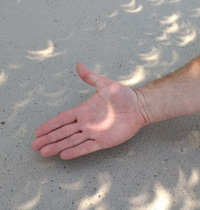The following is a short report from Bernard McCarty, a long time supporter of SolarAid who donates a proportion of the money generated by his home Solar PV system via direct debit each month. Here he explains how he offset his “space trip” by donating to SolarAid.
This summer, the arrival of a ‘big birthday’ provided the perfect excuse for myself, nephew and brother-in-law (all confessed space nerds) to go on the trip of a lifetime to witness the 2017 Total Eclipse in Nashville, Tennessee and visit some of NASA’s famous spaceflight centres at Marshall and Cape Kennedy. It has been a long been our dream to see the original Apollo spacecraft and launch sites that took men from the Earth to the Moon – nearly 50 years ago!

SolarAid light charging in Nashville
Unfortunately, one downside to such a trip would be the carbon emissions incurred by our cross Atlantic round trip from the UK to the US. Thanks to SolarAid’s impact calculator we could ensure that our journey would have a positive impact on others less fortunate than ourselves with whom we share our planet. The purchase of some lamps and a small donation later – we were ready for lift-off!
 While a total solar eclipse is naturally a humbling reminder of the awesome power of the Sun, it turned out that solar power was also a common theme on our road trip across the US between the NASA sites. From the size and scale of the Skylab solar panels on display at Marshall to the acres of solar panels surrounding Kennedy Space Centre, the original development of solar energy for spaceflight – these days used safely and cleanly down here on Earth – is now saving lives through the work SolarAid.
While a total solar eclipse is naturally a humbling reminder of the awesome power of the Sun, it turned out that solar power was also a common theme on our road trip across the US between the NASA sites. From the size and scale of the Skylab solar panels on display at Marshall to the acres of solar panels surrounding Kennedy Space Centre, the original development of solar energy for spaceflight – these days used safely and cleanly down here on Earth – is now saving lives through the work SolarAid.
 It was a pilgrimage I will never forget and am so grateful for SolarAid to have provided the means for us to help in a small way. Please consider a helping them when next you take a flight – as we saw with the returning of the Sun after the eclipse – light really does change everything.
It was a pilgrimage I will never forget and am so grateful for SolarAid to have provided the means for us to help in a small way. Please consider a helping them when next you take a flight – as we saw with the returning of the Sun after the eclipse – light really does change everything.
Thank you,
Bernard McCarty, UK. 2017
If you are interested in offsetting your carbon from flights, travel or other activities please visit our impact calculator to see how many solar lights it takes…